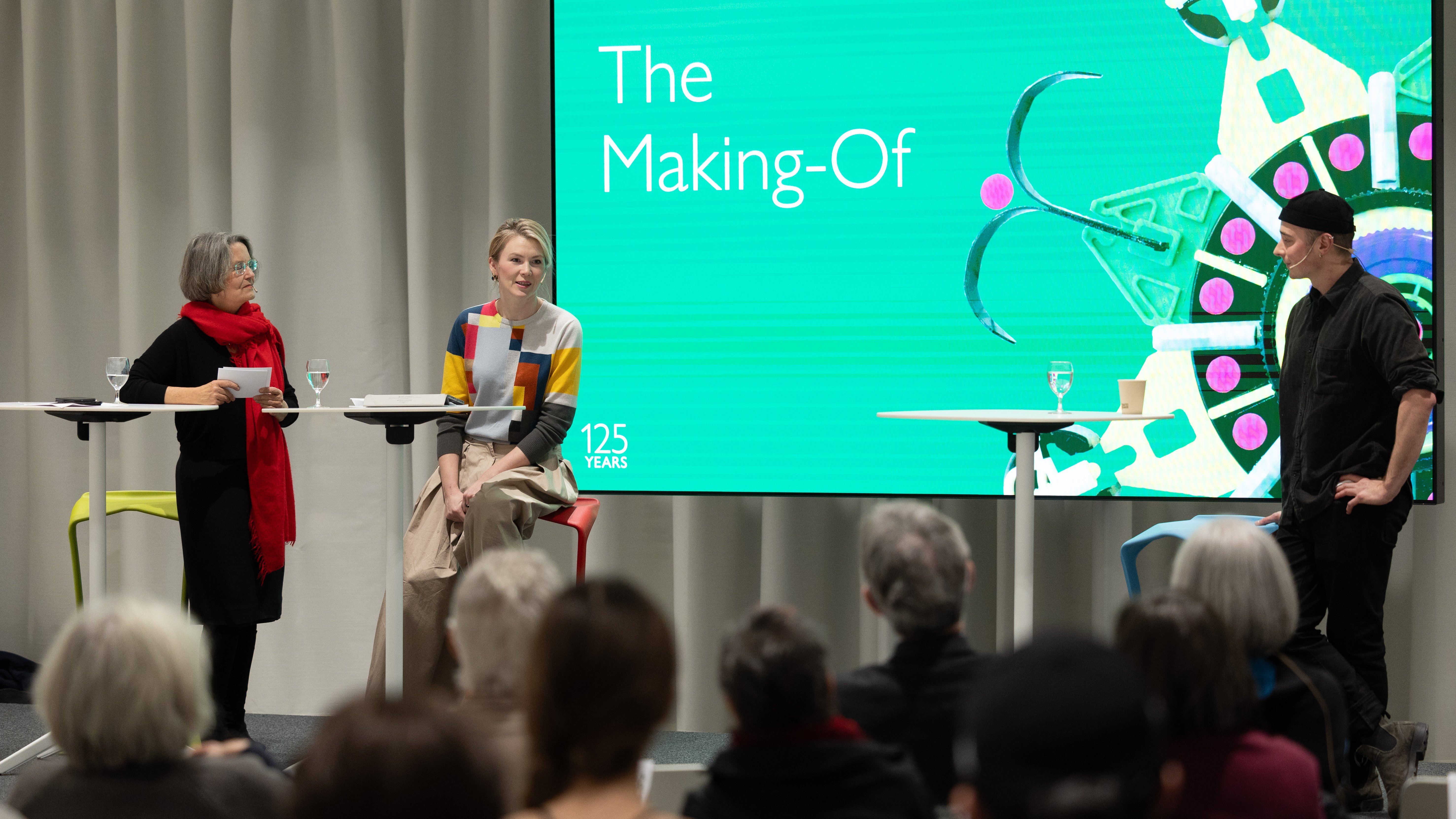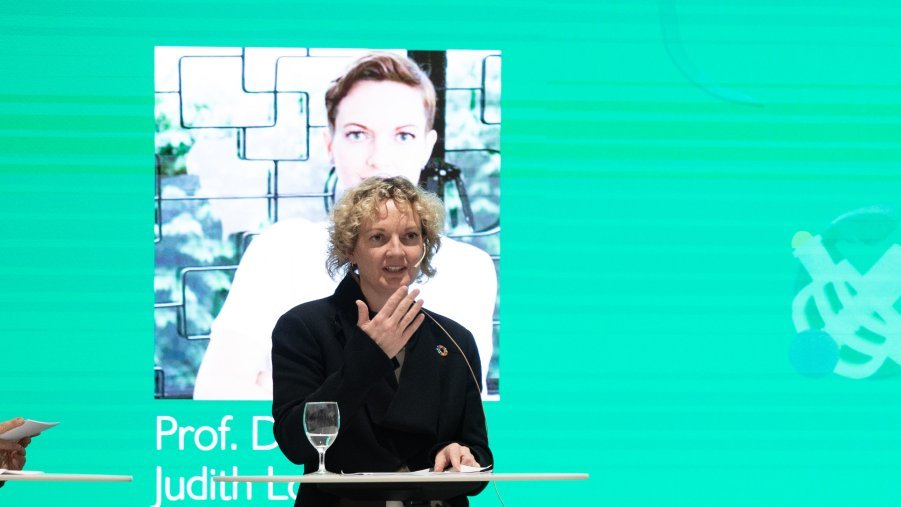Campus - 06.12.2023 - 14:00
Lewis Davidson’s St.Gallen Clicker" – A new work of art at HSG
125 years of HSG. At the end of the anniversary year there is a "Clicker”. A what? A clicker, more precisely the "St.Gallen Clicker". A sculpture made from recycled plastic, created by the English mixed media artist Lewis Davidson on behalf of the University of St.Gallen. The work was unveiled on 4 December 2023 and transferred to HSG's spectacular art collection, which is open to the public.

The work was unveiled on 4 December 2023 and transferred to HSG's spectacular art collection, which is open to the public.
What is it? Stunned, you stand in before it and wonder, well, what is it? In front of this mysterious machine, is it a track for marbles or a water fountain? It is "the St.Gallen Clicker", a sculpture made of plastic, colourful, playful, mysterious. It was created by Lewis Davidson, born in 1990, who lives and works in London. He collected the plastic in the course of HSG's anniversary year. Printer cartridges, loose-leaf binders, plastic tubes, socket covers and everything else you can imagine. In the process, he has had 140 conversations with those who have given him the things that have often become useless. Students, service staff and professors. In this way, Lewis Davidson got to know HSG from the inside, from its waste, its workrooms, its people and life at the University, which is as colourful as the plastic he transported to his studio in London.
Why Clicker?
The name refers to the sound of plastic being clicked together. Click! What becomes of this PET bottle? Click! What becomes of this pen? Click! Old becomes new. Click! An idea becomes reality. Click! Waste now has new value. Click! A lot of HSG in it. Click! After a year, there it was, the St.Gallen Clicker. Now it can be marvelled at. First in the SQUARE, later in the main building. Click, click, click! But no matter how many times it clicks, this wondrously beautiful object retains its mystery. It remains open to many interpretations.
President Bernhard Ehrenzeller emphasised in his welcoming speech that the work could be seen as a symbol for our organisational machine, with so many inferred meanings, connections and links that create a network, just like the complexities of the University. He also praised the cheerful side of the work. Its humour is omnipresent. He also thanked Gulnaz Partschefeld, who, as project manager, had not only initiated the work, but also accompanied its realisation throughout the year.




“KUNST-Stoff”
In the discussion with Yvette Sanchez and Lewis Davidson, led by author Sieglinde Geisel, who wrote the book about the 125th anniversary, Gulnaz Partschefeld talked about the beginnings of the collaboration, which started under the title "KUNST-Stoff". Lewis Davidson visited St.Gallen four times for this project. For example, when a container full of carefully collected plastic was disposed of by Caretaking Services. Is that art or can it go? Lewis Davidson himself is fascinated by the creation of new, enigmatic logic that a work like the St.Gallen Clicker embodies. The finished work has a pleasant form of self-evidence, he said with British understatement.
Prof. em. Yvette Sanchez, head of the Art Committee, introduced Davidson and his work and gave an initial categorisation of it. She paid tribute to "18 Flags", an early work with which Lewis Davidson had already attracted attention in 2014 as part of the art@tell programme at HSG. With a broad view of other contemporary artworks made of plastic, she emphasised: "In the great mass of sculptural objets trouvés in art, St.Gallen Clicker stands out due to the aspect of sophisticated machines, i.e. mechanical engineering in art." The categorisations and interpretations continued in the second part of the vernissage. Professors from HSG thought aloud about the St.Gallen Clicker against the background of their respective disciplines. The discourse brought with it a small display of fireworks.


Creating new values
Professor Judith Walls began by illustrating the omnipresence of plastic, which is no longer just a unique material in its own way. Whether as waste or in the form of microplastics, it can now be found in the oceans as well as in the human placenta. She then placed the artwork in the context of the so-called Anthropocene, i.e. the human-dominated geological era in which we currently find ourselves.
Clicker is “a commentary on our society today. Davidson's choice to use plastic as a widely available and common material highlights the pervasiveness of plastic in our world. And of course, we all know that plastic is bad for the environment.” But the Professor of Corporate Sustainability Management did not stop there. Looking at the St.Gallen Clicker, she said euphorically: “Lewis’s work is also an inspiration for solutions to environmental problems. His artwork is an excellent example of how value can be created from working within constraints and reusing (waste) materials. This gives us hope that human creativity, ingenuity, and innovation can lead the way. In his case, the outcome is art – an emotion and visual symbol to be admired for generations. There is no reason to believe we cannot do the same within business.”
Paula Bialski, professor of Digital Social Science, emphasised the sociological side of the artwork, calling Lewis Davidson's working method ethnographic. “Cables, beams, plastic tubes and wires, discarded utensils and tools, as he uses them, are part of the social culture of our daily lives. Our material infrastructure is social and linked to social meaning such as class, power and hierarchy." With regard to the St.Gallen Clicker she concluded that we need, "ethnographic and artistic forms of slowness and care that Lewis exhibited here that help us observe these hidden meanings behind our material objects – like maintenance and repair.”

![[Translate to English:] Paula Bialski](https://www.unisg.ch/fileadmin/_processed_/f/3/csm_KUNST-Stoff-075_282ebfde78.jpg)
Social sculpture
In his presentation, Professor Roland Füss mused that the St.Gallen Clicker could not be reduced to the topics of environmental protection and recycling. Füss saw references to Joseph Beuys' "social sculpture" and said, "It is the process of collecting things from employees of our university in different professions and different hierarchical levels and unifying it in something new that puts them on an equal footing with each other.”
It was an evening of amazement and reflection. In the presence of a visibly moved Lewis Davison, who was overwhelmed by the wealth of inspiring thoughts that his work had already triggered. One thing is certain so far: There is a lot of HSG in the St.Gallen Clicker. More than you would expect at first glance at this wonderful, colourful and playful work of art.